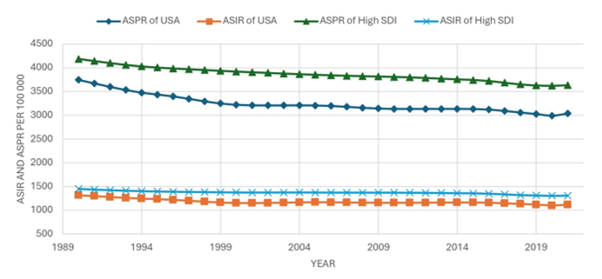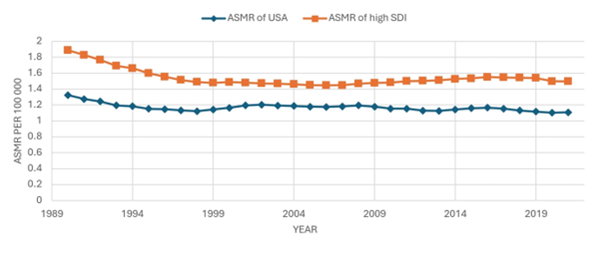Tuesday Poster Session
Category: Biliary/Pancreas
P4303 - Temporal Trends in Incidence, Mortality and Prevalence of Gallbladder and Biliary Diseases in High-Income Countries Compared to the USA,1990-2021
Tuesday, October 28, 2025
10:30 AM - 4:00 PM PDT
Location: Exhibit Hall
- NW
Niven Wang, DO
University of New Mexico
Albuquerque, NM
Presenting Author(s)
Muhammad A. Nadeem, MD1, Anna Willingham, 2, Abdul Awan, MBBS3, Niven Wang, DO2, Fatima Ashfaq, MBBS3, Abdullah Ahmad, 4, Niloy Ghosh, MD5, Amir Sohail, MD, MSc2, Abu Baker Sheikh, MD5
1Cleveland Clinic, Cleveland, OH; 2University of New Mexico, Albuquerque, NM; 3Nishtar Medical University, Multan, Punjab, Pakistan; 4CMH Lahore Medical College, Albuquerque, NM; 5University of New Mexico Health Sciences Center, Albuquerque, NM
Introduction: Gallbladder and biliary diseases are significant contributors to the global health burden, with variations in incidence, prevalence, and mortality influenced by lifestyle, risk factors, and healthcare access. While previous studies have analyzed trends in these diseases, limited research directly compares gender-related patterns between high-income countries (high SDI) and the United States. This study aims to evaluate the long-term trends in age-standardized incidence (ASIR), prevalence (ASPR), and mortality (ASMR) rates for gallbladder and biliary diseases between these regions from 1990 to 2021.
Methods: This study utilized data from the Global Burden of Disease (GBD) 2021 database. Age-adjusted incidence, prevalence, and mortality rates were extracted for gallbladder and biliary diseases in the United States and high SDI countries. Joinpoint regression analysis was applied to calculate annual percentage changes (APCs) with 95% confidence intervals (CIs) to identify significant trend shifts over time.
Results: Among males in high SDI countries, ASMR declined from 2.03 to 1.67, ASPR from 3210.0 to 2962.4, and ASIR from 987.4 to 932.0 per 100 000. In females, ASMR decreased from 1.79 to 1.34, ASPR from 5141.8 to 4352.3, and ASIR from 1912.0 to 1706.7 per 100 000. Among US males, ASMR decreased from 1.57 to 1.29, ASPR from 2495.8 to 2278.2, and ASIR from 757.5 to 716.0 per 100 000. Among females, the ASMR decreased from 1.17 to 0.96, the ASPR from 4921.6 to 3796.5, and the ASIR from 1856.5 to 1519.4 per 100 000.
Discussion: This study highlights a significant decline in mortality and prevalence of gallbladder and biliary diseases in both high SDI countries and the United States from 1990 to 2021, with incidence rates showing minor declines or stability. Despite these improvements, the U.S. continues to exhibit a higher disease burden, likely due to obesity, metabolic disorders, and disparities in healthcare access. Addressing modifiable risk factors and implementing equitable healthcare policies is essential for reducing the burden of gallbladder and biliary diseases and improving health outcomes globally.

Figure: Joinpoint regression analysis of ASMR of High SDI and USA

Figure: Joinpoint regression analysis of ASIR and ASPR of High SDI Countries and USA
Disclosures:
Muhammad Nadeem indicated no relevant financial relationships.
Anna Willingham indicated no relevant financial relationships.
Abdul Awan indicated no relevant financial relationships.
Niven Wang indicated no relevant financial relationships.
Fatima Ashfaq indicated no relevant financial relationships.
Abdullah Ahmad indicated no relevant financial relationships.
Niloy Ghosh indicated no relevant financial relationships.
Amir Sohail indicated no relevant financial relationships.
Abu Baker Sheikh indicated no relevant financial relationships.
Muhammad A. Nadeem, MD1, Anna Willingham, 2, Abdul Awan, MBBS3, Niven Wang, DO2, Fatima Ashfaq, MBBS3, Abdullah Ahmad, 4, Niloy Ghosh, MD5, Amir Sohail, MD, MSc2, Abu Baker Sheikh, MD5. P4303 - Temporal Trends in Incidence, Mortality and Prevalence of Gallbladder and Biliary Diseases in High-Income Countries Compared to the USA,1990-2021, ACG 2025 Annual Scientific Meeting Abstracts. Phoenix, AZ: American College of Gastroenterology.
1Cleveland Clinic, Cleveland, OH; 2University of New Mexico, Albuquerque, NM; 3Nishtar Medical University, Multan, Punjab, Pakistan; 4CMH Lahore Medical College, Albuquerque, NM; 5University of New Mexico Health Sciences Center, Albuquerque, NM
Introduction: Gallbladder and biliary diseases are significant contributors to the global health burden, with variations in incidence, prevalence, and mortality influenced by lifestyle, risk factors, and healthcare access. While previous studies have analyzed trends in these diseases, limited research directly compares gender-related patterns between high-income countries (high SDI) and the United States. This study aims to evaluate the long-term trends in age-standardized incidence (ASIR), prevalence (ASPR), and mortality (ASMR) rates for gallbladder and biliary diseases between these regions from 1990 to 2021.
Methods: This study utilized data from the Global Burden of Disease (GBD) 2021 database. Age-adjusted incidence, prevalence, and mortality rates were extracted for gallbladder and biliary diseases in the United States and high SDI countries. Joinpoint regression analysis was applied to calculate annual percentage changes (APCs) with 95% confidence intervals (CIs) to identify significant trend shifts over time.
Results: Among males in high SDI countries, ASMR declined from 2.03 to 1.67, ASPR from 3210.0 to 2962.4, and ASIR from 987.4 to 932.0 per 100 000. In females, ASMR decreased from 1.79 to 1.34, ASPR from 5141.8 to 4352.3, and ASIR from 1912.0 to 1706.7 per 100 000. Among US males, ASMR decreased from 1.57 to 1.29, ASPR from 2495.8 to 2278.2, and ASIR from 757.5 to 716.0 per 100 000. Among females, the ASMR decreased from 1.17 to 0.96, the ASPR from 4921.6 to 3796.5, and the ASIR from 1856.5 to 1519.4 per 100 000.
Discussion: This study highlights a significant decline in mortality and prevalence of gallbladder and biliary diseases in both high SDI countries and the United States from 1990 to 2021, with incidence rates showing minor declines or stability. Despite these improvements, the U.S. continues to exhibit a higher disease burden, likely due to obesity, metabolic disorders, and disparities in healthcare access. Addressing modifiable risk factors and implementing equitable healthcare policies is essential for reducing the burden of gallbladder and biliary diseases and improving health outcomes globally.

Figure: Joinpoint regression analysis of ASMR of High SDI and USA

Figure: Joinpoint regression analysis of ASIR and ASPR of High SDI Countries and USA
Disclosures:
Muhammad Nadeem indicated no relevant financial relationships.
Anna Willingham indicated no relevant financial relationships.
Abdul Awan indicated no relevant financial relationships.
Niven Wang indicated no relevant financial relationships.
Fatima Ashfaq indicated no relevant financial relationships.
Abdullah Ahmad indicated no relevant financial relationships.
Niloy Ghosh indicated no relevant financial relationships.
Amir Sohail indicated no relevant financial relationships.
Abu Baker Sheikh indicated no relevant financial relationships.
Muhammad A. Nadeem, MD1, Anna Willingham, 2, Abdul Awan, MBBS3, Niven Wang, DO2, Fatima Ashfaq, MBBS3, Abdullah Ahmad, 4, Niloy Ghosh, MD5, Amir Sohail, MD, MSc2, Abu Baker Sheikh, MD5. P4303 - Temporal Trends in Incidence, Mortality and Prevalence of Gallbladder and Biliary Diseases in High-Income Countries Compared to the USA,1990-2021, ACG 2025 Annual Scientific Meeting Abstracts. Phoenix, AZ: American College of Gastroenterology.
